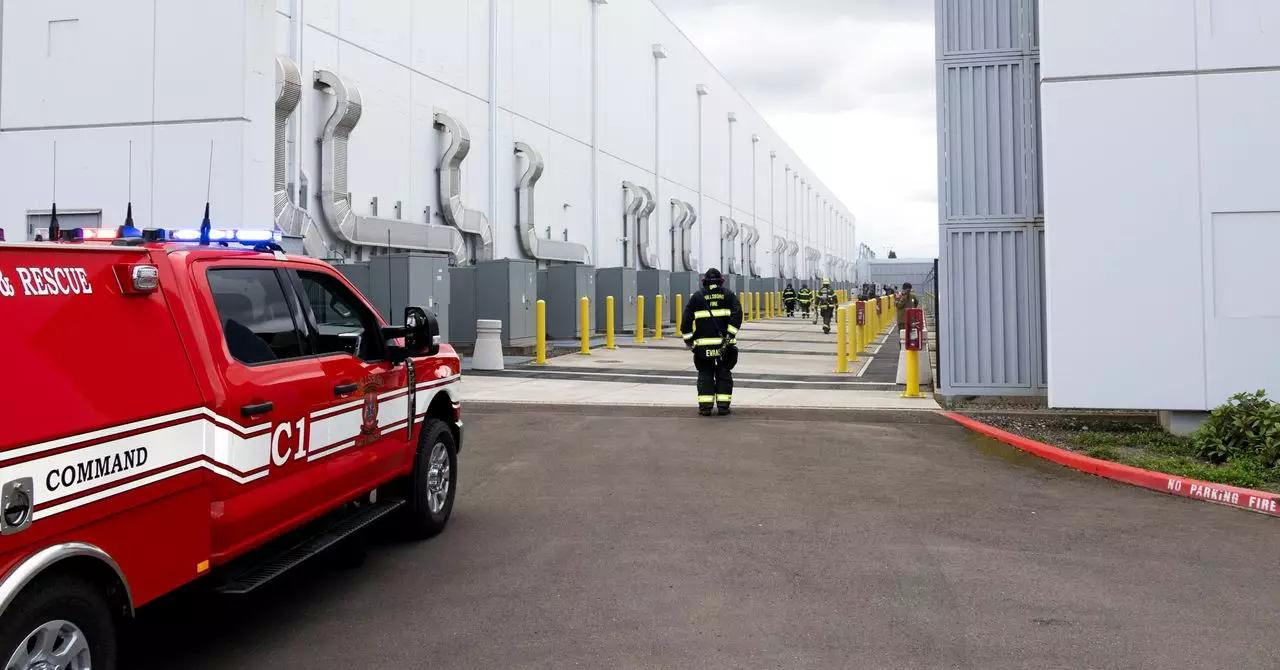In recent years, the digital landscape has become heavily reliant on massive data centers that process, store, and distribute the world’s information. Despite being technological marvels, these facilities are not immune to catastrophic failures. The recent fire incident at Elon Musk’s X data center in Hillsboro, Oregon, underscores an alarming reality: as our dependence on complex computational infrastructure grows, so does the potential for destructive failures. Data center fires, once considered rare anomalies, are now revealing themselves as more than just isolated events—they are symptoms of an overstressed, increasingly vulnerable system.
The Hillsboro blaze, stretching over hours and resulting in substantial material loss, shines a spotlight on a critical weakness: the electrical and mechanical resilience of data center power systems. With the rapid expansion of artificial intelligence capabilities demanding larger computational clusters, the strain on these facilities intensifies. This scenario presents a paradox—while advancements enable unprecedented technological progress, they concurrently escalate risks lurking within our digital backbone.
The Fragile Heart: Power Systems Under Pressure
The core of the Hillsboro fire appears to be linked to an uninterruptible power supply (UPS) cabinet. UPS units are essential, acting as a bridge to ensure continuous power supply during outages. However, their significance does not mitigate their own vulnerabilities. These units, housing large batteries and intricate circuitry, are susceptible to failures, especially under abnormal operating conditions such as overloads or electrical faults.
Electrical engineers warn that such systems are like double-edged swords; they provide vital stability but can become sources of disaster if flaws emerge. The incident report indicates that the fire initiated within the UPS cabinet, although investigators could not definitively establish the root cause. Theories center around electrical failure or mechanical malfunction—troubles that could be exacerbated by intense load demands from AI operations or inadequate cooling.
This raises a profound concern: are current standards and maintenance practices sufficient to safeguard these power systems? If not, fires could become a recurring threat, especially as data centers push their operational limits and adopt more aggressive cooling and power strategies to meet worldwide digital demand.
Technological and Operational Risks in the Age of AI
The escalation of AI development is a double-edged sword. While the capabilities of generative models are transforming industries and everyday life, their power demands are substantial. Large clusters of GPUs and CPUs draw enormous amounts of energy, increasing not only operational costs but also the risk profile of data centers.
Increased power density could lead to overheating, which, if unchecked, might trigger fires or other failures. The Hillsboro incident suggests that even well-engineered systems are susceptible, especially when rapidly scaled up to meet surging technological demands. The possibility that an electrical fault ignited a key component underscores a broader vulnerability: as data centers expand, so does the complexity of their power and cooling systems, often amplifying fault potential.
Operationally, this incident emphasizes the need for rigorous thermal management and proactive failure detection. Data centers must evolve from reactive maintenance to predictive, sensor-driven systems that can preempt issues before they escalate into disasters. The cost of negligence—both financial and reputational—becomes painfully clear in the aftermath of such events.
Consequences Beyond Material Damage
Beyond the immediate concerns of fire damage and financial loss, data center failures threaten broader societal stability. Data centers serve critical functions—from banking and healthcare to government operations. Disruptions can cascade into service outages, data loss, and compromised security.
The Hillsboro fire resulted in a $260,000 estimate in damages, including the destruction of one power cabinet and damage to neighboring units. While no injuries were reported, incidents like this reveal the latent risk of operational paralysis that can take days or weeks to repair. With increasingly integrated infrastructure, such failures may not stay localized, potentially causing widespread disruptions across sectors.
Furthermore, the incident triggers questions about corporate responsibility and resilience. Companies like Digital Realty acknowledge the issues but remain tight-lipped about specific corrective actions. Transparency and accountability are crucial to restoring confidence and preventing recurrence—yet many organizations may lack the necessary visibility into vulnerabilities within their infrastructures.
The Road Ahead: Rethinking Data Center Safety
This event should serve as a clarion call for the industry: our data centers must be reimagined for resilience in the face of escalating demands. It’s no longer sufficient to rely solely on traditional safeguards; innovative cooling techniques, smarter power management, and rigorous safety protocols need prioritization.
One promising approach is integrating advanced monitoring systems utilizing AI itself—creating a feedback loop of predictive maintenance. These systems could identify early warning signs, such as abnormal temperature variations or electrical irregularities, enabling pre-emptive responses before fires ignite. Additionally, designing modular systems that can isolate faults quickly could contain damage and prevent extensive outages.
Regulatory frameworks should also evolve to mandate stricter standards for power and thermal management, holding operators accountable for safety beyond minimal compliance. The industry must adopt a culture of proactive risk assessment, focused not just on uptime but on the long-term safety and sustainability of critical infrastructure.
The Hillsboro fire exemplifies the urgent necessity to scrutinize and bolster our digital infrastructure’s safety protocols. As our dependence on data-intensive technologies deepens, so must our commitment to ensuring these systems are resilient against the unseen threats that could destabilize our digital future.


Leave a Reply